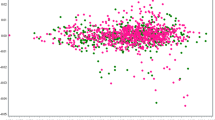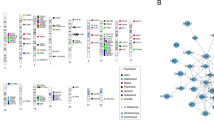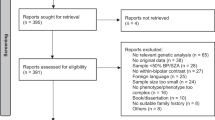Abstract
Lithium is an effective mood stabilizer for bipolar disorder patients and its therapeutic effect may involve inhibition of inositol monophosphatase activity. In humans, the enzyme is encoded by two genes, IMPA1 and IMPA2. IMPA2 maps to 18p11.2, a genomic interval for which evidence of linkage to bipolar disorder has been supported by several reports. We performed a genetic association study in Japanese cohorts (496 patients with bipolar disorder and 543 control subjects). Interestingly, we observed association of IMPA2 promoter single nucleotide polymorphisms (SNPs) (−461C and −207T) with bipolar disorder, the identical SNPs reported previously in a different population. In vitro promoter assay and genetic haplotype analysis showed that the combination of (−461C)–(−207T)–(−185A) drove enhanced transcription and the haplotypes containing (−461C)–(−207T)–(−185A) contributed to risk for bipolar disorder. Expression study on post-mortem brains revealed increased transcription from the IMPA2 allele that harbored (−461C)–(−207T)–(−185A) in the frontal cortex of bipolar disorder patients. The examination of allele-specific expressions in post-mortem brains did not support genomic imprinting of IMPA2, which was suggested nearby genomic locus. Contrasting to a prior report, therapeutic concentrations of lithium could not suppress the transcription of IMPA2 mRNA, and the mood-stabilizing effect of lithium is, if IMPA2 was one of the targets of lithium, deemed to be generated via inhibition of enzymatic reaction rather than transcriptional suppression. In conclusion, the present study suggests that a promoter haplotype of IMPA2 possibly contributes to risk for bipolar disorder by elevating IMPA2 levels in the brain, albeit the genetic effect varies among populations.
Similar content being viewed by others
Log in or create a free account to read this content
Gain free access to this article, as well as selected content from this journal and more on nature.com
or
References
Altshuler D, Brooks LD, Chakravarti A, Collins FS, Daly MJ, Donnelly PA (2005). Haplotype map of the human genome. Nature 437: 1299–1320.
Aoki-Suzuki M, Yamada K, Meerabux J, Iwayama-Shigeno Y, Ohba H, Iwamoto K et al (2005). A family-based association study and gene expression analyses of netrin-G1 and -G2 genes in schizophrenia. Biol Psychiatry 57: 382–393.
Barrett JC, Fry B, Maller J, Daly MJ (2005). Haploview: analysis and visualization of LD and haplotype maps. Bioinformatics 21: 263–265.
Belmaker RH, Shapiro J, Vainer E, Nemanov L, Ebstein RP, Agam G (2002). Reduced inositol content in lymphocyte-derived cell lines from bipolar patients. Bipolar Disord 4: 67–69.
Berrettini WH, Ferraro TN, Goldin LR, Weeks DE, Detera-Wadleigh S, Nurnberger Jr JI et al (1994). Chromosome 18 DNA markers and manic-depressive illness: evidence for a susceptibility gene. Proc Natl Acad Sci USA 91: 5918–5921.
Berridge MJ, Downes CP, Hanley MR (1989). Neural and developmental actions of lithium: a unifying hypothesis. Cell 59: 411–419.
Buckland PR (2004). Allele-specific gene expression differences in humans. Hum Mol Genet 13: R255–R260.
Corradi JP, Ravyn V, Robbins AK, Hagan KW, Peters MF, Bostwick R et al (2005). Alternative transcripts and evidence of imprinting of GNAL on 18p11.2. Mol Psychiatry 10: 1017–1025.
Cryns K, Shamir A, Shapiro J, Daneels G, Goris I, Van Craenendonck H et al (2006). Lack of lithium-like behavioral and molecular effects in IMPA2 knockout mice. Neuropsychopharmacology (in press).
Delaval K, Feil R (2004). Epigenetic regulation of mammalian genomic imprinting. Curr Opin Genet Dev 14: 188–195.
Detera-Wadleigh SD, Badner JA, Berrettini WH, Yoshikawa T, Goldin LR, Turner G et al (1999). A high density genome scan detects evidence for a bipolar susceptibility locus on 13q32 and other potential loci on 1q32 and 18p11.2. Proc Natl Acad Sci USA 96: 5604–5609.
Dimitrova A, Milanova V, Krastev S, Nikolov I, Toncheva D, Owen MJ et al (2005). Association study of myo-inositol monophosphatase 2 (IMPA2) polymorphisms with bipolar affective disorder and response to lithium treatment. Pharmacogenomics J 5: 35–41.
Dinan TG (2002). Lithium in bipolar mood disorder. BMJ 324: 989–990.
Dudbridge F (2003). Pedigree disequilibrium tests for multilocus haplotypes. Genet Epidemiol 25: 115–121.
Evans DL, Charney DS, Lewis L, Golden RN, Gorman JM, Krishnan KR et al (2005). Mood disorders in the medically ill: scientific review and recommendations. Biol Psychiatry 58: 175–189.
Gabriel SB, Schaffner SF, Nguyen H, Moore JM, Roy J, Blumenstiel B et al (2002). The structure of haplotype blocks in the human genome. Science 296: 2225–2229.
Gould TD, Quiroz JA, Singh J, Zarate Jr CA, Manji HK (2004). Emerging experimental therapeutics for bipolar disorder: insights from the molecular and cellular actions of current mood stabilizers. Mol Psychiatry 9: 734–755.
Gurvich N, Klein PS (2002). Lithium and valproic acid: parellels and contrasts in diverse signaling contexts. Pharmacol Ther 96: 45–66.
Harwood AJ (2005). Lithium and bipolar mood disorder: the inositol-depletion hypothesis revisited. Mol Psychiatry 10: 117–126.
Heinemeyer T, Wingender E, Reuter I, Hermjakob H, Kel AE, Kel OV et al (1998). Databases on transcriptional regulation: TRANSFAC, TRRD, and COMPEL. Nucleic Acids Res 26: 364–370.
Kunugi H, Iijima Y, Tatsumi M, Yoshida M, Hashimoto R, Kato T et al (2004). No association between the Val66Met polymorphism of the brain-derived neurotrophic factor (BDNF) gene and bipolar disorder in Japanese: a multi-center study. Biol Psychiatry 56: 376–378.
Lin P-I, McInnis MG, Potash JB, Willour VL, Mackinnon DF, Miao K et al (2005). Assessment of the effect of age at onset on linkage to bipolar disorder: evidence on chromosomes 18p and 21q. Am J Hum Genet 77: 545–555.
Munakata K, Tanaka M, Mori K, Washizuka S, Yoneda M, Tajima O et al (2004). Mitochondrial DNA 3644TC mutation associated with bipolar disorder. Genomics 84: 1041–1050.
Nakayama J, Yamamoto N, Hamano K, Iwasaki N, Ohta M, Nakahara S et al (2004). Linkage and association of febrile seizures to the IMPA2 gene on human chromosome 18. Neurology 63: 1803–1807.
Nemanov L, Ebstein RP, Belmaker RH, Osher Y, Agam G (1999). Effect of bipolar disorder on lymphocyte inositol monophosphatase mRNA levels. Int J Neuropsychopharmacol 2: 25–29.
Ohnishi T, Ohba H, Seo K-C, Im J, Sato Y, Iwayama Y et al (2007). Spatial expression patterns and biochemical properties distinguish a second myo-inositol monophosphatase, IMPA2 from IMPA1. J Biol Chem 282: 637–646.
Pritchard JK, Stephens M, Donnelly P (2000). Inference of population structure using multilocus genotype data. Genetics 155: 945–959.
Schneider S, Roessli D, Excoffier L (2000). Arlequin: A Software for Population Genetics Data Analysis, Ver 2.000. Genetics and Biometry Laboratory, Department of Anthropology, University of Geneva.
Seelan RS, Parthasarathy LK, Ranga N, Parthasarathy RN (2004). Lithium modulation of the human inositol monophosphatase 2 (IMPA2) promoter. Biochem Biophys Res Commun 324: 1370–1378.
Segurado R, Detera-Wadleigh SD, Levinson DF, Lewis CM, Gill M, Nurnberger Jr JI et al (2003). Genome scan meta-analysis of schizophrenia and bipolar disorder part III: bipolar disorder. Am J Hum Genet 73: 49–62.
Shaltiel G, Shamir A, Nemanov L, Yaroslavsky Y, Nemets B, Ebstein RP et al (2001). Inositol monophosphatase activity in brain and lymphocyte-derived cell lines of bipolar patients. World J Biol Psychiatry 2: 95–98.
Shamir A, Ebstein RP, Nemanov L, Zohar A, Belmaker RH, Agam G (1998). Inositol monophosphatase in immortalized lymphoblastoid cell lines indicates susceptibility to bipolar disorder and response to lithium therapy. Mol Psychiatry 3: 481–482.
Sjøholt G, Ebstein RP, Lie RT, Berle JO, Mallet J, Deleuze JF et al (2004). Examination of IMPA1 and IMPA2 genes in manic-depressive patients: association between IMPA2 promoter polymorphisms and bipolar disorder. Mol Psychiatry 9: 621–629.
Sjøholt G, Gulbrandsen AK, Løvlie R, Berle JØ, Molven A, Steen VM (2000). A human myo-inositol monophosphatase gene (IMPA2) localized in a putative susceptibility region for bipolar disorder on chromosome 18p11.2: genomic structure and polymorphism screening in manic-depressive patients. Mol Psychiatry 5: 172–180.
Torrey EF, Webster M, Knable M, Johnston N, Yolken RH (2000). The Stanley Foundation brain collection and Neuropathology Consortium. Schizophr Res 44: 151–155.
Wang L, Liu X, Lenox RH (2001). Transcriptional down-regulation of MARCKS gene expression in immortalized hippocampal cells by lithium. J Neurochem 79: 816–825.
Williams RS, Cheng L, Mudge AW, Harwood AJ (2002). A common mechanism of action for three mood-stabilizing drugs. Nature 417: 292–295.
Yamada K, Ohnishi T, Hashimoto K, Ohba H, Iwayama-Shigeno Y, Toyoshima M et al (2005). Identification of multiple serine racemase (SRR) mRNA isoforms and genetic analyses of SRR and DAO in schizophrenia and D-serine levels. Biol Psychiatry 57: 1493–1503.
Yoon IS, Li PP, Siu KP, Kennedy JL, Cooke RG, Parikh SV et al (2001). Altered IMPA2 gene expression and calcium homeostasis in bipolar disorder. Mol Psychiatry 6: 678–683.
Yoshikawa T, Kikuchi M, Saito K, Watanabe A, Yamada K, Shibuya H et al (2001). Evidence for association of the myo-inositol monophosphatase 2 (IMPA2) gene with schizophrenia in Japanese samples. Mol Psychiatry 6: 202–210.
Yoshikawa T, Padigaru M, Karkera JD, Sharma M, Berrettini W, Esterling LE et al (2000). Genomic structure and novel variants of myo-inositol monophosphatase 2 (IMPA2). Mol Psychiatry 5: 165–171.
Yoshikawa T, Turner G, Esterling LS, Sanders AR, Detera-Wadleigh SD (1997). A novel human myo-inositol monophosphatase gene, IMP.18p, maps to a susceptibility region for bipolar disorder. Mol Psychiatry 2: 393–397.
Acknowledgements
This work was supported by RIKEN BSI Funds (TK and TY), Research on Brain Science Funds from the Ministry of Health Labor and Welfare (TY), Grant-in Aid from the MEXT (TO), Grant from Mitsubishi Pharma Research Foundation (TY) and CREST funds from the Japan Science and Technology Agency, Japan (NO and TY).
Author information
Authors and Affiliations
Corresponding author
Additional information
Supplementary Information accompanies the paper on the Neuropsychopharmacology website (http://www.nature.com/npp)
Rights and permissions
About this article
Cite this article
Ohnishi, T., Yamada, K., Ohba, H. et al. A Promoter Haplotype of the Inositol Monophosphatase 2 Gene (IMPA2) at 18p11.2 Confers a Possible Risk for Bipolar Disorder by Enhancing Transcription. Neuropsychopharmacol 32, 1727–1737 (2007). https://doi.org/10.1038/sj.npp.1301307
Received:
Revised:
Accepted:
Published:
Issue date:
DOI: https://doi.org/10.1038/sj.npp.1301307
Keywords
This article is cited by
-
Progress and Implications from Genetic Studies of Bipolar Disorder
Neuroscience Bulletin (2024)
-
IP3 accumulation and/or inositol depletion: two downstream lithium’s effects that may mediate its behavioral and cellular changes
Translational Psychiatry (2016)
-
A Role for the PKC Signaling System in the Pathophysiology and Treatment of Mood Disorders: Involvement of a Functional Imbalance?
Molecular Neurobiology (2011)
-
In silico study on the substrate binding manner in human myo-inositol monophosphatase 2
Journal of Molecular Modeling (2011)
-
Analysis of a t(18;21)(p11.1;p11.1) translocation in a family with schizophrenia
Journal of Human Genetics (2009)



